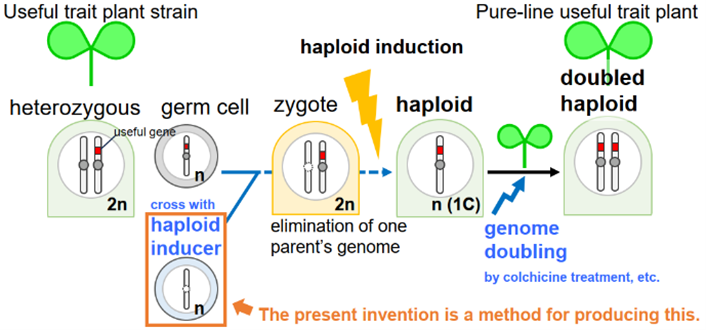Advantages
- This technique is applicable to a wide variety of flowering plant species whereas previous haploid breeding techniques could only be applied to specific plant species.
- After successful haploid induction, the genome of the haploid inducer line possessing the transgene cassette is removed, resulting in double haploid plants that are safely transgene-free.
 |
Current Stage and Key Data
- A haploid inducer line has been created by introducing a specific gene cassette into Arabidopsis thaliana.
- Crossing an Arabidopsis pistil (female) from the haploid inducer line with a gl1 recessive mutant lacking trichomes (hair-like structures on the surface of leaves for a rapid screening of seedlings in this case) generates offsprings exhibiting the gl1 phenotype, indicative of haploid plants losing the inducer’s genome. This offspring was confirmed to be a haploid by ploidy analysis.
- This strategy could be applied to many flowering plant species other than Arabidopsis because the gene and system used in our haploid inducer technique is conserved among flowering plant species.
Partnering Model
We are seeking partner companies that develop/provide the haploid inducer technology and apply it to useful plants such as tomatoes and soybeans We are also looking for companies that will establish novel, rapid breeding programs using this haploid inducer technique. We are open to feasibility studies and licensing, including joint research.
- Potential partner examples: Companies involved in plant breeding and improvement (seed companies, plant factories, plant bioengineering companies, grain and vegetable production companies, food companies, floriculture, greening and landscaping companies, etc.).
Background
Haploid breeding is an important technique for rapidly establishing pure-line individuals from useful strains with non-fixed genotypes. It has previously been achieved in a limited number of plant species under specific conditions, including interspecific pollination in wheats (the so-called “Bulbosum” method) and anther or ovule culture techniques. However, these methods are difficult to practically apply to designated plant species due to a lack of universality, so a simple, versatile haploid induction method is desired. In this regard, the present invention is an innovative technique that enables haploid breeding to be applied to various plant species.
Publications and Patents
- In preparation for paper submission. Patent pending.
Principal Investigator
Hidenori TAKEUCHI (Institute of Transformative Bio-Molecule, Nagoya University, Tokai National Higher Education and Research System)
* Currently affiliated with the Graduate School of Arts and Sciences, The University of Tokyo.
Project ID:BK-04895


